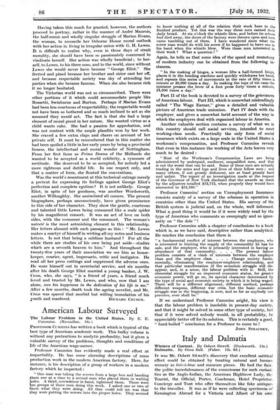American Labour Surveyed
The Labour Problem in the United States. By E. E. Cummins. (Macmillan. 18s.)
PROFESSOR CUMMINS has written a book which is typical of the best type of American academic work. This bulky volume is without any pretentions to analytic profundity, but it gives a valuable survey of the problems, thoughts and conditions of life of the American wage-earner.
Professor Cumtnins has evidently made a real effort at Impartiality. He has some alarming descriptions of mass production work in the modern American factory. Here, for instance, is his description of a group of workers in a modern factory which he inspected :
" One man was taking the screws from a large box and handing them one at a time to a second man who placed them in waiting holes. A third, screwdriver in hand, tightened them. There were ten groups of three men doing this work. - I waked one or two of them what they were doing. All they could tell me was that they were'putting the screws into the proper_holes. They seemed to know nothing at all of the relation their work bore to the finished product. Yet this was the way these men earned their daily bread. At six o'clock the whistle blew, and before its echoes had died away, the doors of the factory were thrown open and men came tumbling out of them. I have wondered since what the screw man would do with his screw if he happened to have one in his hand when the whistle blew. Were these men interested in their work 2 What a question ! "
Again, he tells us that some idea of the speed and monotony of modern industry can be obtained from the following in. stances.
" In the making of hinges, a woman lifts a half-formed hinge, places it in the bending machine and quickly withdraws her hand, and repeats this series of movements at the rate of fifty times a minute pr 30,000 times a day. In making the tops of tin cans the operator presses the lever of a foot press forty times a minute, 24,000 times a day."
Part II of the book is devoted to a survey of the grievances of American labour. Part III, which is somewhat misleadingly called " The Wage Earner," gives a detailed and valuable picture of American trade unionism. Part IV deals with the employer, and gives a somewhat lurid account of the way in which the employers deal with organized labour in America.
Another valuable section contains a survey of what we in this country should call social services, intended to meet working-class needs. Practically the only form of social insurance which exists on a large scale in the United States is workman's compensation, and Professor Cummins reveals that even in this instance the working of the Acts leaves very much to be desired :
" Most of the Workman's Compensation Laws are being administered by underpaid, mediocre, unqualified men, and that is not the worst that can be said. Some of these men are actually trading in the arms and legs and lives of their fellow men ; and many others, if not grossly dishonest, are at least grossly hard and unfair. The report of an investigation made at the request of the Governor of New York disclosed that the awards as made by the adjusters totalled $13,712, when properly they would have amounted to $52,280."
Professor Cummins' section on Unemployment Insurance consists mainly of a survey of the schemes in operation in countries other than the United States. His survey of the British system is judicial and, on the whole, well informed. What a good thing it would be if it were widely read by the type of American who comments so sweepingly and so ignor- antly on " the dole " !
Professor Cummins adds a chapter of conclusions to a book which is, as we have said, descriptive rather than analytical. He reaches the conclusion that there is
" a fundamental conflict of interest between the employee, who is interested in limiting the supply of the commodity he has for sale, and the employer, who is primarily interested in having an abundance of that commodity. . . . The present labour problem consists of a clash of. interests between the employer class and the employee class. . . . Change society funda- mentally, -eliminating the employer-employee relationship, and that particular manifestation of the -economic struggle will dis- appear, and, in a sense, the labour problem with it. Still, the elemental struggle for an improved economic status, for greater economic power, will go on, its special character determined by the type of social and economic society in which it is being waged. There will be a different alignment, different method, perhaps different weapons, different war cries, but the basic economic struggle was in the beginning, is now, and so far as anybody can perceive, ever shall be.
If we understand Professor Cummins aright, his view is that the labour ,problem is insoluble in present-day society, and that it might be solved in some other type of society, but that if it were solved nobody would, in all probability, be appreciably better off for its.solution. This is -certainly a good, " hard-boiled " conclusion for a Professor to come to ! JOHN STRACHEY.


































 Previous page
Previous page